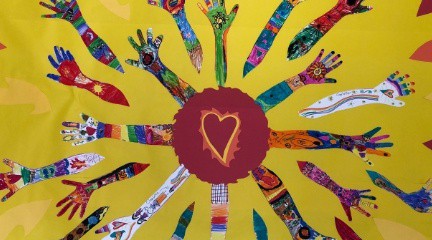
by West | Oct 23, 2018 | Blogs, Home Page News, Rainbow Institute
In 2012 Rainbow Community School (RCS) was selected as an Ashoka Changemaker School, a network of schools that empower students as changemakers by prioritizing empathy, leadership, and collaborative problem-solving as student outcomes. They recognize the capacities of young people to make a BIG difference and highlight empathy as the centerpiece for all changemaking efforts. RCS was nominated as a changemaker School because of its belief that educating for the wholechild directly impacts humanity’s collective awareness and capacity for growth.
The Journey from I to We:
Gandhi’s wise words remind us that it all begins with our inner selves: “Be the change that you wish to see in the world.” At RCS, we believe that real change originates out of an individuals’ commitment to their own evolution. As a result, we strive to support all learners in becoming whole, finding purpose and then making change. Our educational model nurtures the holistic development of the child and by doing so, these whole humans are better equipped and more empowered to serve the needs of humanity and the planet through their positive change making efforts.
It is not uncommon for our learners to acknowledge that before they can show up for others they must show up for themselves and it is the emphasis on self-discovery and personal well-being that opens the doors to connection, collaboration and thus meaningful work. Our students explore, at a very young age, what it means to “know thyself” by recognizing their unique gifts and exploring practices that highlight self-empathy and self-gratitude.
By inviting a child’s inner life into the classroom we are awakening their spirit. A spiritually nourished child is not only ready to learn but it’s the child’s strong spiritual identity that is the catalyst for meaningful work. The catalyst for change!
There are certain stand out elements of the Rainbow Seven Domains Learning Model that help to create favorable conditions for spiritual identity development and the daily centering practice is one of them. This morning ritual serves to awaken the spiritual center of each child, opening pathways to learning. As a centering begins, the classroom is filled with ritual and reverence. These rituals vary from classroom to classroom but the essence of centering is such that the students gather in a circle on a rug, the space is set with intention, the lights are dimmed, a chime or bell invites silence, reverence fills the room, a pause is taken for audible breath work, the invitation of fire through candlelight is summoned- this begins the sacred work of the day. The results are often a harmonious learning environment in which focused thinking come naturally, trust among the group yield effortless work and innovative solutions are manifested.
Recently I joined Lucy and the preschool Dragonflies for centering. The preschool centering ritual leader began by asking his class to put on their mindful bodies and their mindful listening ears. He then told them that he would ring the singing bowl and wanted every person to actively and mindfully listen until they could no longer hear the song of the bell and then to raise their hand when its song was gone. He then used a breathing ball and guided his classmates in three deep inhales and exhales. As the ball expanded he said aloud “inhale” and as it contracted he said “exhale.”
Lucy, then invited the preschoolers to join her in a self-affirming morning verse that was paired with sign language. The kids spoke the words with confidence and enthusiasm… “May I be healthy, may I be strong, may I be happy, may I be peaceful.” I was happy to witness the use of self-affirmations with such young learners. Positive affirmations or positive self-talk are great motivators for self-reflection and self-change. Statements such as these can easily become identity statements. Thus, benefiting not only oneself but those that you interact with.
Lucy deepened the experience by extending the lesson. She went on to explain that each person would have the opportunity to choose a kind wish they have for themselves. She showed and read the kind wish cards aloud and asked to kids to be thinking about which kind wish they wanted for themselves today. When the kids were ready to share, they signaled to Lucy by placing their thumbs on their knees.
She invited each them to approach the altar which was filled with the kind wish cards, candles and the wishing water. The kids were asked to speak their kind wish aloud and in the direction of the wishing water. It was obvious that Lucy had worked hard to create a supportive and safe yet vulnerable space for the Dragonflies as each child spoke, the rest of the group held a quiet space.
Finally, Lucy reminded the children that much like plants need our care to thrive, our intentions and affirmations need that attention too. As the centering practice came to a close, she explained, that she would take the wishing water (filled with their wishes) and send the kind wishes in to the world by watering the plants and that the plant’s health and growth will be a visual reminder of our own personal growth.
If we feed our body, it can grow. If we feed our mind, it can be stimulated. If we nurture our spirit, it can flourish. What daily affirmations will help you flourish?
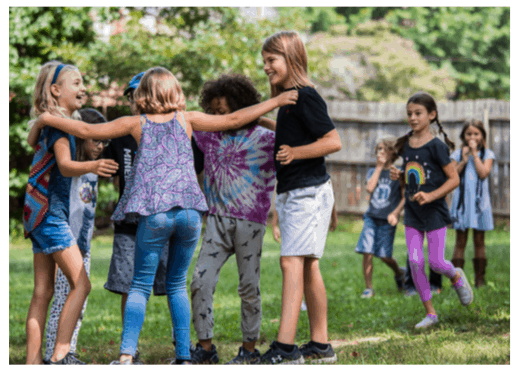
by West | Oct 23, 2018 | Blogs, Home Page News, Rainbow Institute
Connection and community at Rainbow is often nurtured through rituals, traditions or celebrations that mark the passage of time. We begin the school year with an opening ceremony during which the entire school comes together to offer blessings and intentions for the coming year. On that same day we also host a Rose Ceremony. This ceremony happens twice each year; on the first day of school and on the last day of school.
The ceremony on the 1st day of school is designed for the oldest students (8th graders) in the school to welcome the 1st graders into elementary school. Each 8th grader gives a 1st grader a rose to symbolize their support as they transition. This important rite of passage is replicated on the last day of school as the 8th graders graduate. The 1st graders offer them a rose to mark their transition.
Also during the first week of school, each class chooses a mascot. Choosing a class mascot has been a community building tradition at Rainbow for years. This tradition yields many benefits. Students are using the mental domain to formulate logical arguments about their mascot choice, the social domain to share their ideas and participate in a democratic voting process, the spiritual domain by learning about symbolism of the mascot and/or striving to embody the qualities of those animals. The mascot provides the class a shared identity and deepens group cohesion.
We also gather for a weekly song circle. This is a simple and joyful way to engage in the universal language of music while also offering a special bonding experience across the age groups.
Additionally, throughout the course of the year, we hold fire circles that help us honor the seasonal cycles and our own inner cycles. The circles foster a support system for deep reflection, invite gratitude and, nurture the well being of all community members who attend. As we gear up for the Fall equinox, a fire burns on campus, extending the invitation to sit, to breathe and to connect.
These are a few of the community connection opportunities offered in the first few weeks of school. We invite you to find ways that integrate modified rituals such as these in your home, classroom or organization.

by West | May 19, 2018 | Blogs, Home Page News, Rainbow Institute
The integrated RCS curriculum fosters learning in a holistic way.
This approach is void of the restrictions often imposed by teaching discreet subjects. Purposeful integration acknowledges, builds on and reinforces the existing relationships between subject areas and/or topics. The hope is that learning is then more easily transferred into other settings.
Integration is also a “brain compatible strategy” as described by brain researcher, Eric Jenson. Jenson (1996) suggests that, “The brain learns best in real-life, immersion-style, multi-path learning [and] fragmented, piecemeal presenting can forever kill the joy and love of learning.” This immersion style is considered a best practice and is embraced by our teachers. It is, therefore, not uncommon for the theme, topic or unit of study to be woven into the fabric of an entire school day, week, and/or month. For example, the element of water and its states of matter are introduced in kindergarten. First grade elaborates on the water cycle and studies rivers and oceans. During these units, water often becomes a central theme that invites cross curricular learning.
Centering offers cross curricular learning opportunities.
The intended purpose of centering is to awaken the spiritual center of each child, opening pathways to learning. The centering practice activity includes a contemplative experience, but teachers also strive to extend the learning by integrating with the academic curriculum. The Mind Jar centering serves as an excellent example. The Mind Jar begins with a conversation about the various properties of water. Perhaps prompted by photographs of water in various forms or by a book such as, The Water Dance by Thomas Locker. Discussion yields a shared understanding of the ways in which water moves- Water is always moving, flowing, changing, essential to life, found deep in the ocean, under the ground, high in the sky, freezing, melting, etc. The focus being more heavily on the magical and mysterious qualities of the element rather than the scientific descriptions.
The teacher guides students to make connections between their own thoughts and feelings to the movements of water in the natural world
(i.e. a raging river can represent anger, a waterfall- excitement, snowfall- peace) After giving an example or two, the children are then prompted to suggest additional feelings and water movements connections. The teacher explains that The Mind Jar is simply a jar filled with water and glitter. But it is representative a tiny world where we can watch the movements of water and match those movements to our own feelings. The water represents our mind’s natural state and the glitter represents our thoughts, emotions, fears, concerns, and wonderings. When the jar is shaken, our thoughts will whirl around and our mind becomes cloudy and hard to see through. But, as the glitter begins to settle and still, so do our thoughts and feelings. It is in this stillness and calm state that we are able to make good decisions.
The Mind Jar is a simple mason jar containing water, glitter, glitter glue, and food coloring.
Combine warm water with the glitter glue, glitter, and food coloring. Close the Jar tightly. Depending on the amount of glue you use, the glitter will settle more slowly. This tool can be used when a child is feeling stressed, overwhelmed or upset. It can calm and relax them. It can serve as a meditation tool or a self-regulation tool. You can explore many versions of this on the web. If you have an interest in extending the learning from this centering, you may want to try a follow up centering using the picture book, Moody Cow Meditates. Peter the cow is moody after having a rough day. A series of unfortunate circumstances leads Peter’s grandfather to teach him how to settle his mind and let go of his frustration using some mediation tools.
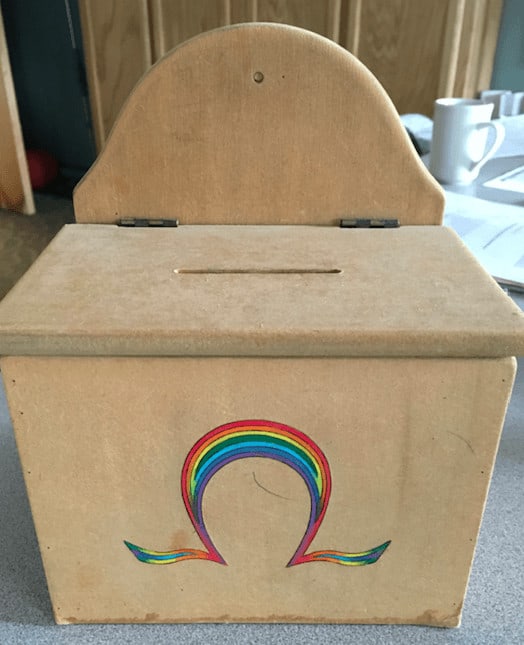
by West | May 2, 2018 | Home Page News, Rainbow Institute
Rainbow Community School had a special guest this week!
Best-selling author and Ph.D., Lisa Miller, toured our school. Lisa authored The Spiritual Child and is also the head of clinical psychology at Columbia University Teachers College. She has conducted and compiled decades of research on spiritual development in children and teens. Her research specifically quantified the effects of healthy spiritual development on mental health, resilience and thriving and provided empirical evidence that children are naturally spiritual beings. Her book also serves as a resource for parents as they navigate the important work of raising spiritual children.
Lisa is currently heading up a new project called the Collaborative for Spiritual Development. This work is aiming to develop resources for educators who wish to nurture their students’ spiritual capacities. Lisa became aware of Rainbow’s 40-year history of embracing a secular spiritual curriculum and as you learned in our Executive Director’s video, she wanted to find out more about how Rainbow is doing just that! We are hoping that her visit will yield new resources for a wide range of educators working to nurture the spiritual identities of their students.
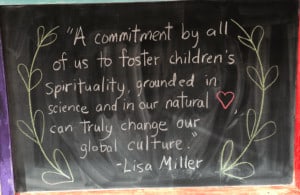
The commitment to this work is outwardly palpable among Rainbow’s staff and faculty and as a result, the spiritual curriculum is woven into the daily rhythm of each classroom.
The RCS spiritual curriculum has four primary aspects under which all its goals and objectives fall:
- Mystery and Contemplation
- Spiritual Virtues
- Ceremony and Celebration
- World Traditions.
Often, a centering practice is developed with one specific aspect in mind. Many Omega Middle School (OMS) centerings embrace theMystery and Contemplationaspect. These centerings welcome the unknown as a source of inspiration and wonder and are filled with questions, quotes or prompts that invite the students to seek deeper meaning and purpose through reflection. Just this morning, for example, Albert Einstein’s wise words were written on the whiteboard as a welcoming for each OMS student upon arrival.
“The important thing is not to stop questioning. Curiosity has its own reason for existing.”
One of the OMS classrooms has a special centering called The Philosopher’s Box. The intended purpose of this centering is to encourage this deep questioning.
To introduce this activity, ask the students what they know about the word “philosophy”, and/or if they know what the role of a philosopher is. Then share the etymology of the word “philosophy.” This word is Latin and Greek in origin and means to love knowledge: Philo=love, Sophia=knowledge. Follow by explaining that philosophy is the study of fundamental questions about the nature of existence, big ideas such as love, truth, beauty, and what it means to lead a fulfilling life.
At this point the teacher introduces the Philosopher’s Box. This is a physical box decorated with a bit of magic and whimsy or as you see fit.
Each student then writes down at least two philosophical “wonderings.” These are questions with no right or wrong answers.
Some examples for students may be:
- “Do you believe life exists on other planets?”
- “Is it important to always be 100% honest and truthful at all times (why or why not?)”
- “Do you believe it’s possible to predict the future?”
- “If you could have the abilities of one animal, which animal would you choose and why (i.e. to fly like a bird or to breath underwater like a fish)?
After giving specific examples, the students are asked to take the next few moments to reflect upon the kinds of open-ended questions they wonder about, and then place their questions in the box. From here there are many options for discussion. The teacher can pick a question at random from the box, and have students take turns answering. Or, students can pair up and discuss their answers with each other. Students and teachers can add to the box throughout the year – for example, when a good “wondering” or “what if?” question comes up during class discussion.
This centering is intended to provide a healthy and intentional space where learners can feel safe and supported as they ponder the “big questions.” Centerings like these help to bring a sense of meaning and purpose into their lives. Research suggests that having a stronger sense of purpose can make a significant difference in our lives. In fact, Lisa Miller’s research, link spiritual purpose to improved health, well-being, and a more meaningful and successful life.
Centerings like these connect our students to something greater than themselves- to something deeply spiritual.

by West | Mar 22, 2018 | Blogs, Home Page News, Rainbow Institute
An altar is commonly associated with a religious purpose. It is often a structure or space, considered sacred, on which offerings are placed and used in a rite or ritual. However, we often create altars to honor various things that aren’t necessarily associated with a religious purpose.
We make altars all the time, some intentionally, some unintentionally and others out of habit. Consider how you may arrange your collectibles, how you may display your family photos or art, or how you may plan your garden. Think about the forts or fairy homes that your kids make in the backyard or how they arrange their special artifacts or favorite toys. With these “altars” we aim to elevate, focus energy and/or bring special attention to something.
Altar creation can be a very powerful process. It provides a space to slow down and reconnect to something very personal or meaningful to you. Creating a spiritual altar can also be a physical and visible representation of an intention you may have. It may also serve as a sacred way to invite spiritual energies and questions into your life . Ultimately, altars become focal points or reminders of our inner spirit and our connection to the divine.
Altars are very much a part of the culture of Rainbow
They are found in every classroom, used each day in centering practices and are often created by the students. The elements used in each altar vary but are often reflective of the season, the theme that the class may be studying, or the message the centering practice intends to convey. Below are some classroom altars.
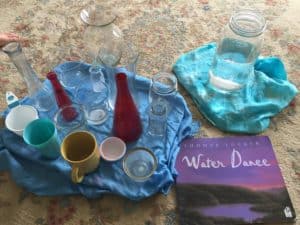
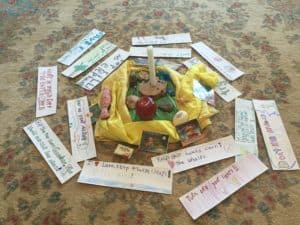
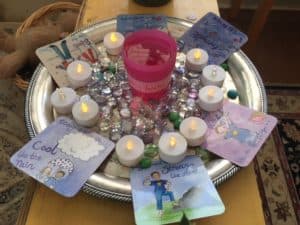
Co-creating altars
In an effort to raise money for their end of year trip, some of our students recently designed, created and sold traveling altars. Each altar provides various resources and tools that may help others to bring a centering practice into the home.
- The tablecloth serves a way to transport the altar as well as an aesthetically pleasing foundation to set up the altar.
- The candle, when lit, sets the tone for the practice and invites spirit into the room. It is also a visible reminder to celebrate the light in ourselves, others and the world around us.
- The shell demonstrates our connection to the natural world. Displaying nature artifacts bring forth the wonder and magic of the natural world and reminds us that time in nature can yield deep connection and contemplation.
- The painted rock displays a word of intention and reminds us to aim to bring positive emotions into our lives.
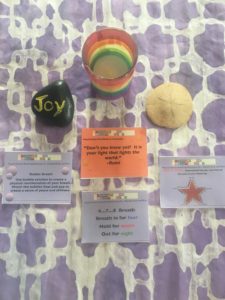
The blue cards share three different breathing techniques that help the mind and body achieve awareness, presence and peace. The orange quote card is intended to engage the reader’s mental domain by encouraging them to reflect on words of wisdom. The yellow cards highlight social conversation questions posed by the students. These cards encourage the readers to ponder big questions such as, “When and how was the universe born?” and “What happens after death?” or ask the reader to personally reflect on things like, “What type of personal do you hope/aim to be?” or What helps you to feel calm and grounded?”
How might these inform your practice?
The creators of these traveling altars were hoping that the altars would prompt centering practices within the home. The elements of each altar are simply starting points out of which family ritual, contemplative practice and spiritual development can grow.
Consider what your family or classroom altar could look like. Where might it live? What elements would you include? What question cards or breathing techniques could be added to this package? What inspirational quotes might serve your family or classroom?

by West | Mar 8, 2018 | Blogs, Home Page News, Rainbow Institute
We live in a time of uncertainty, in a world that is unpredictable and in a society that is, in some cases, changing rapidly and in others stuck. Nevertheless, our work as educators is more important now than ever.
As an organization, we aim to live our mission everyday. Some days we do so effortlessly and seamlessly. Other days we detour, stumble and struggle. Many days yield cheer and celebration, yet many yield mistakes and misunderstanding. Regardless of the outcomes, we see them ALL as an opportunity to deeply reflect, adapt and grow.
We are an organization on a transformational journey informed by these opportunities, guided by our hearts and our spirits and fueled by our mission.
We develop accomplished, confident, and creative learners who are prepared to be compassionate leaders in building a socially just, spiritually connected, and environmentally sustainable world.
As a teacher, to live this mission means that you are intentional about circling back to it and that you are willing to hold a mirror up to your classroom culture and programming. These opportunities often show up in unexpected ways but, if you are waiting with that mirror, some amazing learning can happen.
Spirit Week at RCS
Next week is Spirit Week at RCS. This week fills our school classrooms, campus and culture with fellowship and fun. It invites costumes, and creativity while building community. As Student Council began to flesh out the daily Spirit Week themes, they stumbled on an opportunity- a real teachable moment. In an effort to give this teachable moment greater context, our Equity Director wrote a letter to our families.
“In the interest of our ongoing efforts to be more mindful of equity, we are eliminating ‘Crazy Hair Day’ from our Spirit Week schedule. There are a couple of concerns about this practice. To begin with, the regular and loose use of the term ‘crazy’ is disrespectful to those who live and struggle with mental illness. Even if we are innocently using the term to refer to something that is different and/or weird, we need to ask ourselves if that’s really the message we want to send about hair. While there are some really cute and elaborate ideas out there for ‘Crazy Hair Day’, all too often, the expressions that come out of this Spirit Week practice are styles that closely resemble (intentionally or not) actual cultural and ethnic hairstyles. The suggestion that those styles are crazy or weird is offensive. Would it be ‘crazy hair’ if a child with curly hair came to school with their hair straightened for the day?
Here at Rainbow, equity is a practice. So we’re using this as a teachable moment for our students. Some of your teachers are taking this time to talk about culture and cultural practices, and concepts of ‘different’ vs. ‘weird’. If you want to continue these discussions at home and feel like you could use some supportive material, please reach out to our Equity Director. In addition, HERE is a link to a very thoughtful post from a parent about ‘Crazy Hair Day’.
Teachable Moments
This topic became inspiration for a 4th grade centering practice. Centering began when the class found stillness and silence. The candle was then lit for “safety” and the teacher began, “Yesterday we talked about physical safety and today we will talk about emotional safety.”
Susie, the teacher, followed by asking for a volunteer to read Rainbow’s mission statement. She then asked, “Where does this come from?” The kids responded, “The School!” She explained that this was our mission statement and ultimately our hope for each action, every day.
Around the altar were the words Ethnic and Culture. The teacher asked the students what these words meant to them. As a group, the kids built collaborative definitions and came to some common understandings of each word. Susie then revealed a final sheet of paper with the phrase ‘Crazy Hair Day’ written on it and began touching on some of the concepts that were explained in the above letter. Finally, she began showing the group images of hairstyles that were based on the cultural or ethnic backgrounds of the people pictured.
These images were passed around the circle in silence. The students were asked to simply use their powers of observation, acknowledge any reactions, consider the terms ‘ethnic’ and ‘culture’ while making mental notes as they cycled through each image.
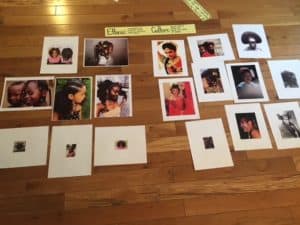
In closing, Susie asked to kids to try to weave all the centering elements together and identify the message that she was trying to share with them. One child responded,”By saying something or someone is crazy, you are judging them.” Another student said, “The things that may be fun for me, like crazy hair day, could really hurt someone else. This might be the way they do things and if you make fun of them, it could hurt their feelings.” Another child said, “What you might consider crazy hair for you may be they way that others wear their hair everyday.” One noted that, “Yesterday we talked about how some cultures greet people in different ways we should think about how some people wear their hair in different ways.” Susie ended with a simple statement about how we, for the last several years have been hosting Crazy Hair Day and upon reflection and insight we have realized that this choice does not fit within our mission statement. As a community, we decided to let go of it because we strive for emotional safety for all.
Now what?
Consider your personal mission statement or that of your school or organization. Reflect…
What are you doing to successfully achieve this mission? Celebrate that!
Now consider, how can those mission statement words be better represented with action?
What changes to your direct practice can open up pathways of learning for you, your family and/or your students?




















